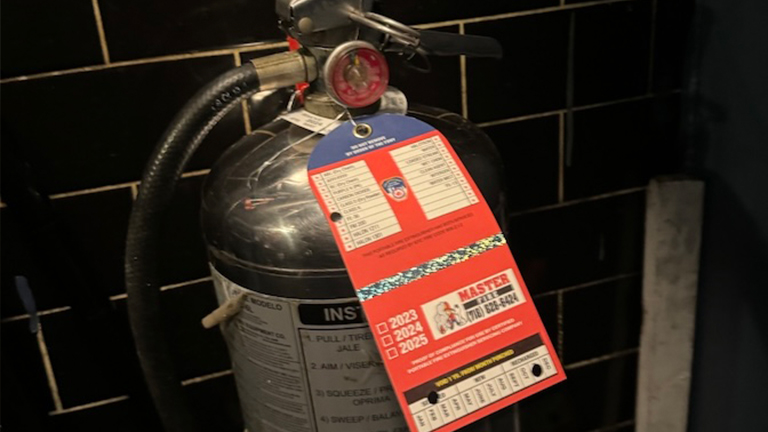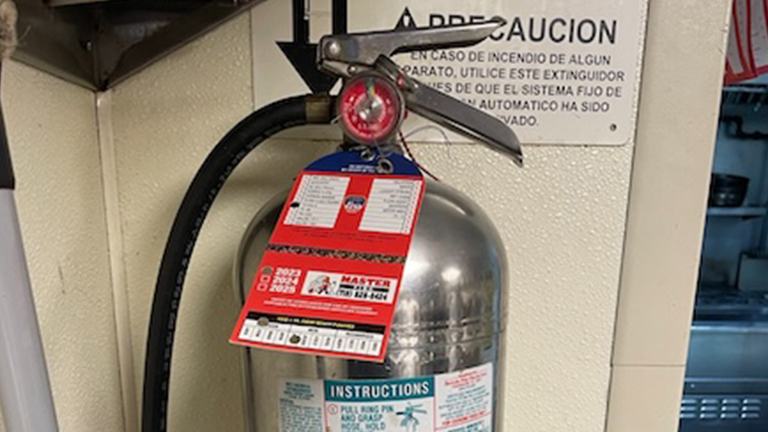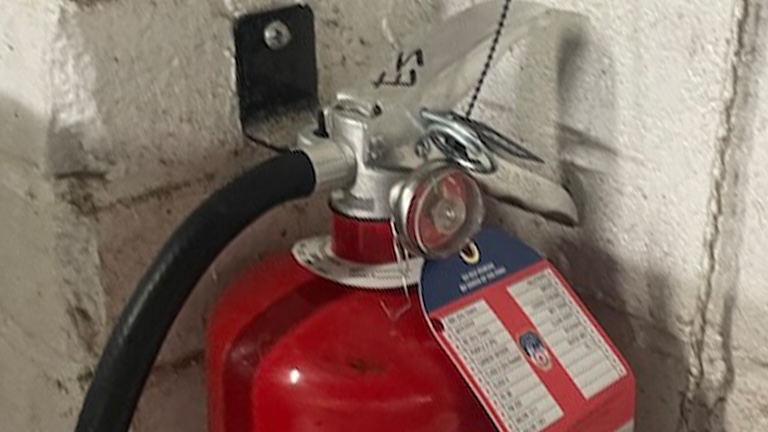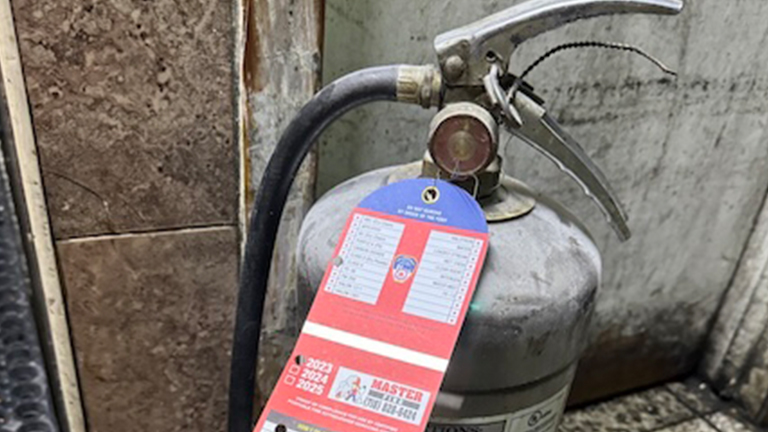
Fire Extinguisher Inspection Manhattan NYC
After Fire Extinguisher Inspection Manhattan Certification Tags are required in order to show FDNY that your restaurant or business is in compliance.
Fire extinguishers are categorized into different classes based on the types of fires they are designed to extinguish. The classification system is typically denoted by a letter and a symbol, and each class corresponds to a specific type of fire. The five main classes of fire extinguishers are:
Class A:
Symbol: Green triangle
Suitable for fires involving ordinary combustible materials like wood, paper, cloth, plastics, and trash.
Extinguishing agent: Water, foam, or dry chemical agents like monoammonium phosphate or sodium bicarbonate
Class B:
Symbol: Red square
Used for flammable liquid fires, including gasoline, oil, grease, and solvents.
Extinguishing agent: Typically dry chemical agents like carbon dioxide (CO2), foam, or dry powder.

Class C:
Symbol: Blue circle
Designed for fires involving electrical equipment or energized electrical circuits.
Extinguishing agent: Typically non-conductive agents like CO2 or dry chemical powders.
Class D:
Symbol: Yellow star
Intended for fires involving combustible metals, such as magnesium, titanium, sodium, and lithium.
Extinguishing agents vary depending on the specific metal involved, and they may include specialized powders or sand.
Class K:
Symbol: Black hexagon
Primarily used for fires involving cooking oils, fats, and grease in commercial kitchens, such as those found in restaurants.
Extinguishing agent: Wet chemical agents designed to saponify and cool the cooking oil to prevent re-ignition.

It’s essential to use the correct type of fire extinguisher for the specific type of fire you are dealing with. Using the wrong type of extinguisher can be ineffective and even dangerous. Additionally, some fire extinguishers are labeled with multiple classes (e.g., ABC or BC), indicating that they are suitable for multiple types of fires.
Not only that but there are regulations and standards, such as NFPA 10 (National Fire Protection Association), OSHA (Occupational Safety and Health Administration), and local fire codes that govern the use of each of these types of fire extinguishers.

At Master Fire our field technicians have the necessary training and certification required to become a fire extinguisher inspector. Many states and countries require certification to perform these inspections. They stay up-to-date with training and keep their certifications current so as to be aware of any regulatory changes. Our equipment including pressure gauges, maintenance equipment, and replacement parts are all best in breed and is regularly calibrated, as well as in good working condition.
We also carry more than the required amount of liability insurance in case of accidents or damages during inspections.

Since 1969 our strong commitment to safety, compliance with regulations, as well as providing high-quality service to clients is well known in New York City. And that goes double for the Bronx.
So remember, after Fire Extinguisher Inspection Manhattan Certification Tags are required in order to show FDNY that your restaurant or business is in compliance.

Fire Extinguisher Inspection Manhattan NYC
After Fire Extinguisher Inspection Manhattan Certification Tags are required in order to show FDNY that your restaurant or business is in compliance.
Property managers and owners in Manhattan know how important it is to get reliable fire extinguisher inspection service. Fire safety starts with being well-prepared and knowledgeable about the industry and safety regulations.
Fire extinguishers are categorized into different classes based on the types of fires they are designed to extinguish. The classification system is typically denoted by a letter and a symbol, and each class corresponds to a specific type of fire. The five main classes of fire extinguishers are:
Class A:
- Symbol: Green triangle
- Suitable for fires involving ordinary combustible materials like wood, paper, cloth, plastics, and trash.
- Extinguishing agent: Water, foam, or dry chemical agents like monoammonium phosphate or sodium bicarbonate.
Class B:
- Symbol: Red square
- Used for flammable liquid fires, including gasoline, oil, grease, and solvents.
- Extinguishing agent: Typically dry chemical agents like carbon dioxide (CO2), foam, or dry powder.
Class C:
- Symbol: Blue circle
- Designed for fires involving electrical equipment or energized electrical circuits.
- Extinguishing agent: Typically non-conductive agents like CO2 or dry chemical powders.
Class D:
- Symbol: Yellow star
- Intended for fires involving combustible metals, such as magnesium, titanium, sodium, and lithium.
- Extinguishing agents vary depending on the specific metal involved, and they may include specialized powders or sand.
Class K:
- Symbol: Black hexagon
- Primarily used for fires involving cooking oils, fats, and grease in commercial kitchens, such as those found in restaurants.
- Extinguishing agent: Wet chemical agents designed to saponify and cool the cooking oil to prevent re-ignition.
It’s essential to use the correct type of fire extinguisher for the specific type of fire you are dealing with. Using the wrong type of extinguisher can be ineffective and even dangerous. Additionally, some fire extinguishers are labeled with multiple classes (e.g., ABC or BC), indicating that they are suitable for multiple types of fires.
Not only that but there are regulations and standards, such as NFPA 10 (National Fire Protection Association), OSHA (Occupational Safety and Health Administration), and local fire codes that govern the use of each of these types of fire extinguishers.
At Master Fire our field technicians have the necessary training and certification required to become a fire extinguisher inspector. Many states and countries require certification to perform these inspections. They stay up-to-date with training and keep their certifications current so as to be aware of any regulatory changes. Our equipment including pressure gauges, maintenance equipment, and replacement parts are all best in breed and is regularly calibrated, as well as in good working condition.
We also carry more than the required amount of liability insurance in case of accidents or damages during inspections.
At Master Fire our goal is to build lasting relationships so we’ll work with you to ensure that you maintain thorough records of all inspections, repairs, and maintenance performed on your fire extinguishers. We’ll also develop a system for scheduling routine inspections to ensure compliance with regulations.
Remember at Master Fire providing excellent customer service is paramount in order for us to build trust and long-term relationships with clients. So you can expect us to be responsive to inquiries and address any concerns promptly.
Since 1969 our strong commitment to safety, compliance with regulations, as well as providing high-quality service to clients is well known in New York City. And that goes double for the Bronx.
So remember, after Fire Extinguisher Inspection Manhattan Certification Tags are required in order to show FDNY that your restaurant or business is in compliance.




